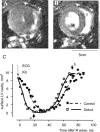Impaired voluntary running capacity of creatine kinase-deficient mice
- PMID: 15831533
- PMCID: PMC1464549
- DOI: 10.1113/jphysiol.2005.086397
Impaired voluntary running capacity of creatine kinase-deficient mice
Abstract
The creatine kinase system (CK) is important for energy delivery in skeletal and cardiac muscles. The two main isoforms of this enzyme, cytosolic MM-CK and mitochondrial mi-CK, are expressed in a developmental and muscle-type specific manner. Mice deficient in one or both of these isoforms are viable and fertile but exhibit profound functional, metabolic and structural muscle remodelling that primarily affects fast skeletal muscles, which show an increased contribution of oxidative metabolism to contractile function. However, the consequences of these alterations in terms of physical capabilities have not yet been characterized. Consequently, we compared the voluntary exercise capacity of 9-month-old male wild-type (WT), M-CK knockout (M-CK(-/-)), and M-CK and mi-CK double knockout (CK(-/-)) mice, using cages equipped with running wheels. Exercise performance, calculated by total distance covered and by work done during the training period, was more than 10-fold lower in CK(-/-) mice than controls, with M-CK(-/-) mice exhibiting intermediate performance. Similarly, the mean distance run per activation was lower in M-CK(-/-) and even lower in CK(-/-) mice. However, the maximal running speed (V(max)) was lower only for CK(-/-) mice. This was accompanied by severe skeletal muscle mass decrease in CK(-/-) mice, with signs of histological damage that included enlarged interstitial areas, aggregations of mononuclear cells in the interstitium, heterogeneity of myofibre size and the presence of very small fibres. No overt sign of cardiac dysfunction was observed by magnetic resonance imaging during dobutamine stimulation. These results show that metabolic failure induced by CK deficiency profoundly affects the ability of mice to engage in chronic bouts of endurance running exercise and that this decrease in performance is also associated with muscle wasting.
Figures






References
-
- Allen DL, Harrison BC, Maass A, Bell ML, Byrnes WC, Leinwand LA. Cardiac and skeletal muscle adaptations to voluntary wheel running in the mouse. J Appl Physiol. 2001;90:1900–1908. - PubMed
-
- Barbato JC, Koch LG, Darvish A, Cicila GT, Metting PJ, Britton SL. Spectrum of aerobic endurance running performance in eleven inbred strains of rats. J Appl Physiol. 1998;85:530–536. - PubMed
-
- Bigard AX, Boehm E, Veksler V, Mateo P, Anflous K, Ventura-Clapier R. Muscle unloading induces slow to fast transitions in myofibrillar but not mitochondrial properties. Relevance to skeletal muscle abnormalities in heart failure. J Mol Cell Cardiol. 1998;30:2391–2401. - PubMed
-
- Bigard AX, Mateo P, Sanchez H, Serrurier B, Ventura-Clapier R. Lack of coordinated changes in metabolic enzymes and myosin heavy chain isoforms in regenerated muscles of trained rats. J Muscle Res Cell Motil. 2000;21:269–278. - PubMed
-
- Boehm E, Ventura-Clapier R, Mateo P, Lechene P, Veksler V. Glycolysis supports calcium uptake by the sarcoplasmic reticulum in skinned ventricular fibres of mice deficient in mitochondrial and cytosolic creatine kinase. J Mol Cell Cardiol. 2000;32:891–902. - PubMed
Publication types
MeSH terms
Substances
LinkOut - more resources
Full Text Sources
Molecular Biology Databases
Research Materials

